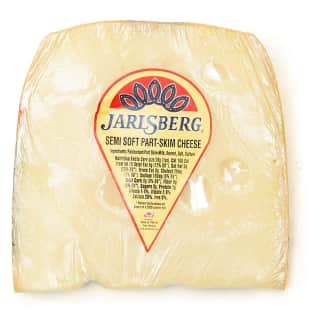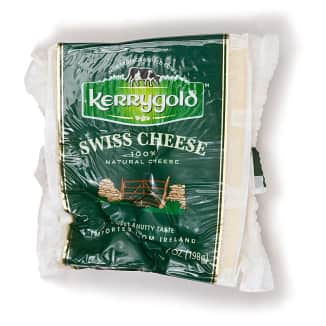Reviews You Can Trust.
See Why.
Swiss Cheese
We scoured supermarket cases, the deli counter, and specialty cheese shops for Swiss that would shine on a cheese plate, not just melt on a sandwich.
Top Pick

WinnerEdelweiss Creamery Emmentaler Switzerland Swiss Cheese
Sign up for the Well-Equipped Cook newsletter
Shop smarter with our ATK Reviews team's expert guides and recommendations.
What You Need to Know
A pockmarked wedge of Swiss may be instantly recognizable as the icon of “cheese,” but it’s rarely celebrated for its flavor. Often rubbery and bland, most Swiss—stateside, at least—may be fine as a gooey layer in a Reuben but would never star on a cheese plate. In fact, there was only one sample that we enjoyed eating out of hand the last time we tasted Swiss cheese, in 2005. That genuine Emmentaler from Switzerland (Emmentaler is the real name for the cheese Americans call Swiss) boasted a nuanced, sweet hazelnut flavor. It also comes with a hefty price tag, thanks to processing standards that go along with its Appellation d’Origine Contrôlée (AOC), or Controlled Term of Origin. This prompted us to shop for comparable, but more affordable, cheeses this time around. But since we were so impressed by the flavors of traditionally made Swiss, we also singled out two high-end mail-order cheeses.
The eight cheeses we came away with spanned a wide spectrum of price points and presentations—and even naming conventions. Three were presliced and five were in wedges. Five were called Swiss and one Jarlsberg, the Norwegian version of Swiss-style cheese. Two were genuine Emmentalers from Switzerland, which wear the full moniker of Emmentaler Switzerland AOC (the word “Emmentaler” itself is not protected, meaning that cheeses with that label can come from anywhere). One of those was our previous winner; the other was a cave-aged product available only via mail order. Finally, we included an Emmentaler from Wisconsin made according to Swiss tradition and available only via mail order.
Flavor Matters
Served plain at room temperature, the cheeses revealed a wide range of flavors and textures—from rubbery, moist, and bland “like string cheese” to drier and more crumbly, with “savory,” “grassy,” “almost gamy” notes that were unexpected in Swiss cheese and had us swooning.
The ingredient labels helped explain these differences. The three strongest-flavored cheeses were all made from raw milk—an ingredient that is part of the centuries-old and now legally enforced recipe for Emmentaler Switzerland AOC. As we knew from previous cheese research, raw milk’s native microflora and enzymes work in tandem with the added cheese cultures to develop the fullest flavor spectrum. The fact that raw milk is so key to a cheese’s flavor development might lead you to wonder why so many producers—including five with cheeses in our lineup—go to the trouble of pasteurizing, but it turns out that there’s a flavor argument for that, too. The native bacteria in raw milk can also produce unpleasant off-flavors, so large companies (which often buy from multiple dairies and therefore have a harder time controlling milk quality) eliminate possible lows—and, by extension, highs—by pasteurizing the milk, relying solely on the starter culture for flavor. Another reason that cheesemakers pasteurize: cost. Strict U.S. Food and Drug Administration regulations require that raw-milk cheeses be aged for 60 days before sale in the United States, and aging is an expensive process.
Of course, aging cheese also improves its flavor. All but one of the cheeses we sampled was aged for at least 60 days, and our preferences generally fell in line with age. The longer a cheese ripened—at least a year for the two top-rated products—the more complex and nuanced its flavor, and the more we liked it. Meanwhile, tasters compared some of the younger samples with Monterey Jack—or even “plastic.” Notably, salt was only a factor for two of the young cheeses. High sodium content is not a characteristic of real Emmentaler, but in these cases it helped mitigate the samples’ blandness.
The age of Swiss cheese is also directly related to its most recognizable feature: the holes. These “eyes” are gas bubbles that form inside the wheels when cultures consume lactic acid in the cheese and release it in the form of carbon dioxide. Young cheeses might have gaps the size of peas, whereas the craters in Emmentaler Switzerland AOC can grow as large as walnuts. We put that theory to the test by measuring the diameter of an average-size hole in each cheese and lining up the samples in ranking order. The correlation was obvious: The more mature cheeses had holes that measured roughly 25 millimeters (about 1 inch) on average, while the cheese that wasn’t aged at all had a single hole less than one-quarter of that size.
Melting Down Preconceptions
There is a downside to buying aged cheeses, however: They don’t melt well—a big problem for a cheese like Swiss that’s routinely melted in sandwiches. Instead, older cheeses become oily and separated when heated, as their proteins break down and release casein molecules that bind together with age to form a tough network that doesn’t melt smoothly.
Given that, we anticipated texture flaws in the older cheeses when we melted all the samples in grilled cheese sandwiches, but we figured that at least their rich, complex flavors would hold up nicely. So imagine our surprise when tasters panned the sandwiches made with the longest-aged wedges—the darlings of our plain tasting—not so much for their texture but for their unpleasant “funky,” “lingering metallic” flavors. Even stranger, heat improved the younger cheeses: Not only did most of them melt beautifully but several young cheeses suddenly gave up “nutty tang.”
Baffled, we contacted Mark E. Johnson, senior scientist at the Wisconsin Center for Dairy Research, who offered a scientific explanation for the flavor transformation: Any cheese will taste sharper as it ages because of the breakdown in its protein matrix, he said, but Emmentaler is different. Byproducts of the very bacteria that provide its unique flavor can also make it too pungent at higher temperatures. In other words, heat was a bane to older Swiss that boasted good flavor straight out of the package but a boon to younger products that took on some character-building nuttiness when melted.
One cheese was the exception: Because it was made from raw milk and aged just a little (four months), it had enough complexity to function as a good snacking cheese and also melted nicely. Otherwise, we recommend shopping for Swiss with a purpose: For heated applications, our recommended younger cheeses are excellent options, but almost any young Swiss will do. For cheese plates, go for aged raw-milk cheeses like our favorite from a Wisconsin-based producer that we think out-Swisses the Swiss.
America's Test KitchenWatch Now
Everything We Tested
Highly Recommended - (For Cheese Plate Only)

WinnerEdelweiss Creamery Emmentaler Switzerland Swiss Cheese

Emmi Kaltbach Cave-Aged Emmentaler Switzerland AOC
Recommended - (For Cheese Plate and Cooking)

Emmi Emmentaler Cheese AOC
Recommended - (For Cooking Only)

Boar’s Head Gold Label Switzerland Swiss Cheese

Norseland Jarlsberg

Kerrygold Swiss Cheese
Not Recommended

Kraft Natural Cheese Big Slice Swiss

Sargento Natural Aged Swiss Deli Style Sliced Swiss Cheese
*All products reviewed by America’s Test Kitchen are independently chosen, researched, and reviewed by our editors. We buy products for testing at retail locations and do not accept unsolicited samples for testing. We list suggested sources for recommended products as a convenience to our readers but do not endorse specific retailers. When you choose to purchase our editorial recommendations from the links we provide, we may earn an affiliate commission. Prices are subject to change.
Reviews You Can Trust
The mission of America’s Test Kitchen Reviews is to find the best equipment and ingredients for the home cook through rigorous, hands-on testing. Have a question or suggestion? Send us an email at atkreviews@americastestkitchen.com. We appreciate your feedback!
Reviews You Can Trust.
See Why.



